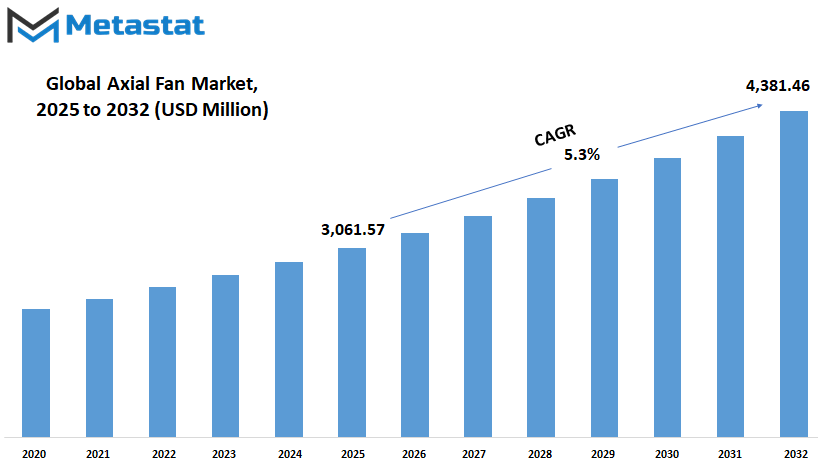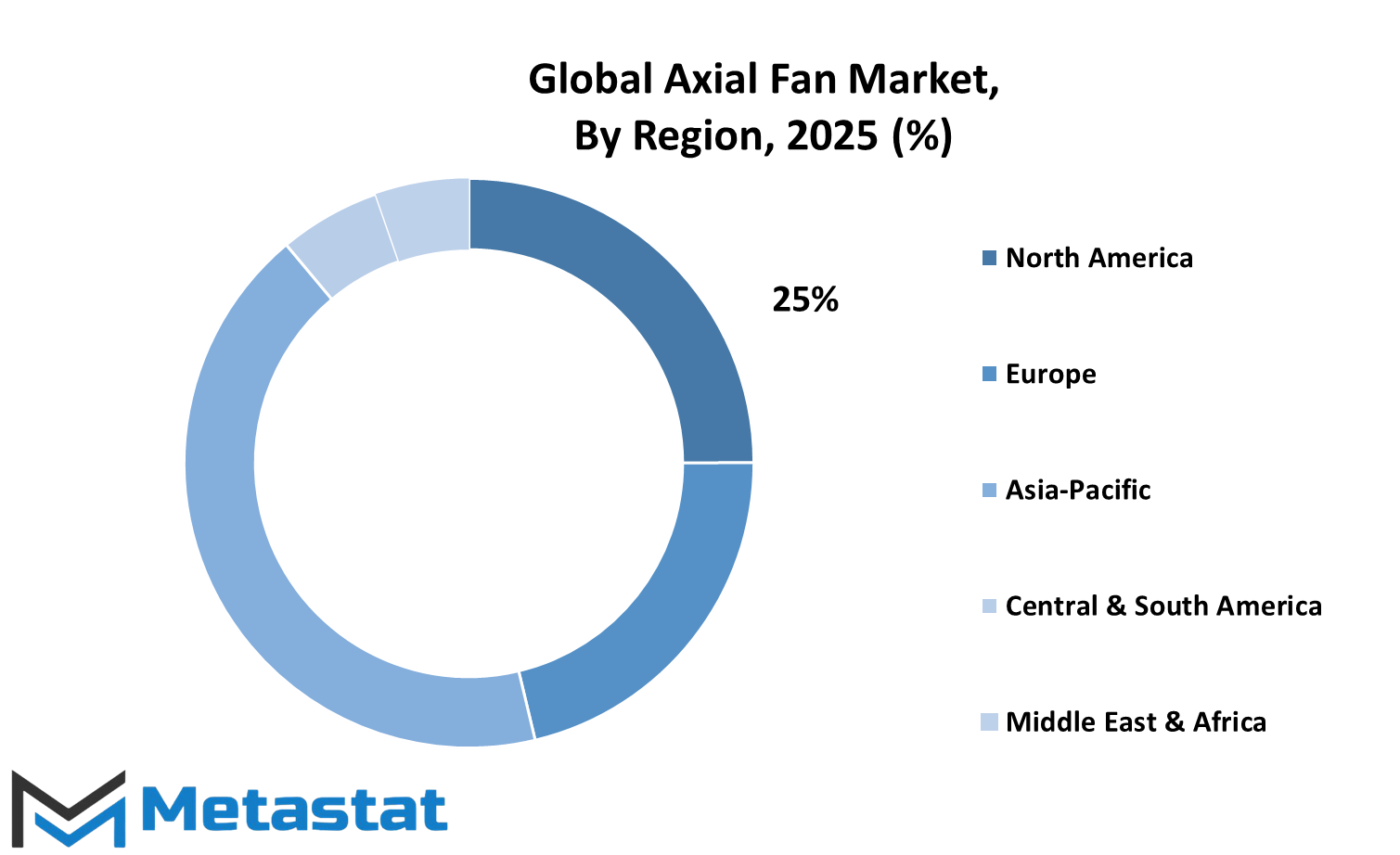MARKET OVERVIEW
The global axial fan market is a sophisticated, specialized market of the overall ventilating and air movement market that deals with the design, production, and distribution of axial fans. Axial fans are essentially fans that produce air movement or gas along the axis of rotation and belong to a number of applications that require efficient air circulation and cooling. Axial fans are unique from other fans as they have a streamlined design, high capacity of airflow that can be produced at relatively low pressure, hence the most sought-after between industrial and commercial uses. The global axial fan market serves many industries including manufacturing, automotive, power generation and HVAC (heating, ventilation and air conditioning).
Every industry employs the individual performance capabilities of axial fans to improve its operations and retain efficiency levels. Industrial plants, for example, employ axial fans to control heat elimination and provide consistent airflow in enclosed areas, while the automotive industry employs them in vehicle cooling systems. Their uses extend even further to data centers, where they play an important role in controlling equipment temperature, making hardware stable and long-lasting. The global axial fan market is expansive because of the versatility of these fans when it comes to configurations, sizes, and materials. Axial fans come in small designs for small devices or large models that can handle heavy-duty industrial environments.
Manufacturers in the market continue to develop innovations that aim to improve performance indicators, including noise reduction, energy conservation, and longevity. These developments are not only directed towards fulfilling the changing requirements of end-users but also to following very stringent environmental and energy regulations that are presently becoming universal across the world. The global axial fan market is controlled by an extensive supply chain of suppliers, distributors, and customers, which gives rise to a competitive market with the need for innovation. The integration of smart technologies and automation in axial fan products is thought to be the direction of the market. These technologies-more significantly, IoT-capable monitoring systems, adaptive speed controls, and predictive maintenance functions-are poised to revolutionize how these fans operate in applications.
This digital shift will allow for improved airflow systems optimization at lower downtime and operating costs. Geographically, the market extends over North America, Europe, Asia-Pacific, etc. All of these territories contribute towards market growth driven by peculiar industrial requirements and infrastructure upgradation. Asia Pacific is a major territory as far as its burgeoning industrial setup, fast pace of urbanization, etc. are concerned. The demand for axial fans in this territory is likely to grow as industries keep intensifying modernization efforts by embracing sophisticated technologies. The global axial fan market is still a significant sector of the air movement industry, expanding in tandem with technological innovation and energy-conscious awareness. As businesses around nearly every corner of the world increase their operations, their demand for dependable and versatile utility-airflow solutions like axial fans will continue to grow. The market will adapt its ongoing innovation and strategic growth as the future will bring to meet the challenges and opportunities on the horizon.
Global axial fan market is estimated to reach $4,381.46 Million by 2032; growing at a CAGR of 5.3% from 2025 to 2032.

GROWTH FACTORS
The global axial fan market is developing rapidly, due to higher requirements for cooling solutions as well as longer HVAC systems. Axial fans are becoming a central component of efficient ventilation through the higher temperatures and intense industrial processes which need an impeccable system of cooling to work without any malfunction. Their capacity for the movement of large amounts of air with lower levels of energy consumption makes them suitable for use in applications as varied as industrial air cooling to commercial air-conditioning installations. With the increasing power of climate change, so too will the likely demand for cooling technology across industries and it will keep driving demand for axial fans in every industry sector. The increase in the installation of HVAC systems also helps a great deal in the expansion of the global axial fan market.
With HVAC, it is really crucial to maintain indoor comfort in any residential or business place. As people are becoming more urbanized and the global population is expanding, the demand keeps on rising and so does their requirement for reliable and efficient axial fans. In addition, as indoor air quality gains more attention, HVAC systems are becoming more complex and more connected with even more energy-saving technology that consequently fuels the need for improved fan systems. The Global Axial Fan industry is promising in its growth potential, yet there are challenges that must be overcome. Centrifugal fans with their own advantages in certain uses do provide some competitive challenges.
Centrifugal fans can manage more pressures and thus are more suited to these applications and hence more preferred in systems where air needs to be transmitted through more resistance or over greater distance. This way, this can inhibit the extensive use of axial fans in certain applications having high pressure, thus curbing the growth of the market. Another reason why the growth of the global axial fan market could be restrained is that there has been a growing focus on energy efficiency standards. The industries and governments everywhere in the world are becoming increasingly stringent in their energy usage and environmental impact. Axial fans, while are extremely energy efficient, may have to shell out for this high energy efficiency due to these newer regulations which could affect manufacturers to re-engineer their product lines.
This would in turn increase production costs, hence impacting growth in certain markets, depending on the regions which could have tight regulations. There are enormous opportunities awaiting the global axial fan market despite these problems. This ranges from increasing industrial automation. With industries seeking means to improve operational efficiency, more automated systems incorporate sophisticated cooling solutions, among them axial fans. The convergence of intelligent technologies and the swiftly growing interest in automation in manufacturing processes will have a big impact on axial fans, which will see noteworthy growth in the next few years. It would still grow, raising the need for effective cooling systems that are dependable as well as powerful enough.
MARKET SEGMENTATION
By Type
Axial fan sales globally are poised to increase further due to greater demand in other industries. These fans play a vital role in creating air flow and providing ventilation in systems, offering effective ways of cooling and air circulation. The industry is hence becoming increasingly segmented as technology surrounding these fans advances, particularly in terms of the power supply involved. By type, the axial fan market across the globe is categorized as AC axial fans, DC axial fans, and EC axial fans. They all serve a purpose in fulfilling particular industry requirements. AC axial fans are powered by alternating current and are demanded extensively across different applications because they are durable and inexpensive.
AC axial fans are most commonly used application areas in industrial cooling systems and big ventilation systems. AC axial fan will continue to be dominant in the market because it provides stable performance for extended periods of time. This model is most suitable for an industry such as HVAC, where efficiency in cooling is important. DC axial fans are, however, powered by direct current and are typically more energy efficient than AC axial fans. They operate on lower voltages and are ideal for applications where energy efficiency is a consideration.
The worth of the DC axial fan market is estimated to be approximately 737.19 million USD. With greater environmental awareness, combined with energy-conserving methods, it is sure to find its way into the next demand for DC fans. Ongoing innovation in materials and technology will see to it that such fans would find their way into numerous newer systems, thus creating more demand for them. This is an electronically commutated motor that possesses characteristics of both an AC fan and a DC fan. They are characterized by high energy efficiency and reliability, and they are gaining popularity in those industries that need accurate airflow control.
EC axial fans give better performance, and their implementation into energy-efficient devices will probably be one of the reasons for their growing popularity. With more companies becoming orientated toward sustainability and carbon footprint reduction in their industries, the markets for EC axial fans will most likely surge forward, and they will become a major force in the international market. There will be significant structural and demand shifts in the global axial fan market during the upcoming several years. Ongoing improvements in fan technology, along with greater focus on energy efficiency and the environment, are likely to spur the axial fan market. With changing types of fans, they will be used in a larger number of industries and applications, ensuring axial fans remain a vital part of any system that demands efficient air movement and cooling mechanisms.
By Speed
The global axial fan industry is developing consistently because of heightened demand across various industries like HVAC, automotive, and electronics. Axial fans find applications in such industries since they can potentially handle the air along the fan axis efficiently. The future of the market will be based on more energy-efficient products and industrial uses evolving in nature. According to speed, the global axial fan market could be segmented into three broad segments: low speed, medium speed, and high speed.
Each of these categories is used for varying performance specifications and for various purposes. Low-speed axial fans are typically applied where there is a need to keep the noise level at a minimum and where energy use is important. These fans are generally used in minor confined spaces, where the air flow is required but not to the extent which a high-speed fan would generate. For example, they are implemented in ventilation systems where the process is supposed to be as silent as possible.
Such utilization entails domestic usage and certain industrial operations. With growing awareness about the use of energy and sound pollution, the low-speed fan demand is anticipated to grow. Medium-speed axial fans are becoming more acceptable in those industries that must weigh energy efficiency against the ability to move high volumes of airflow. The fans are a compromise, offering a solid airflow solution for rooms of moderate size like commercial buildings, warehouses, and larger industrial facilities. With the increasing demand for improved temperature control in these rooms, more medium-speed fans will be operating, particularly as industries strive towards improved environmental sustainability.
High-speed axial fans, although more power intensive, are intended for use where high pressure and air volume are of prime importance. Heavy industries such as manufacturing, power plants, and automobile industries are typical uses. The requirement of these kinds of fans is expected to increase with the development in cooling systems and ventilation systems of high-performance areas. With continued innovation in industries, these fans will be crucial in guaranteeing that operations are smooth while controlling thermal loads.
By Application
In the recent past, the global axial fans market for has experienced tremendous growth and development, in consideration of expanding demand in various industries. Axial fans have an important function in providing the required ventilation, cooling, and refrigeration solution to keep any application at a specified range.
In the future, it seems that the market will be growing based on expanding demands for energy-efficient systems, along with technological development. With the changing industries, most of this growth will be due to the need for axial fans in some applications. The most significant application for the global axial fan market is on radiators. In this application, fans are utilized to control temperature. In this place, air flow cools down the system. This application will be significant as the automobile and industrial sectors shift towards an improved cooling system.
There is growing need for electric cars and energy-saving machines that will propel the demand for axial fans in radiator systems. Axial fans are extensively used in refrigerators, air conditioners, and industrial cooling equipment for temperature regulation. Axial fans for refrigeration and cooling will be highly sought after with greater sustainability and lower energy consumption in the world. Its low energy usage to provide high airflow makes it the most suitable in addressing increasing needs for efficient cooling systems.
In the coming years, the demand for energy-saving axial fans in cooling and refrigeration systems will experience high growth with stricter environmental policies. Ventilation is also another significant segment of the global axial fan market. Axial fans assist in the preservation of indoor air quality, safety, and comfort of occupants within the residential and commercial environment. Increasing in the future will be the application of axial fans in ventilation systems owing to the rising concern over indoor air quality and the environment. Axial fans will be strongly necessary in industrial complexes, offices, and homes to provide an efficient ventilation solution as per the standards prescribed by the governing bodies and demand of the consumers. Apart from this, axial fans are also applied in agricultural, mining, and sewage treatment industries where air flow is a fundamental requirement to attain their maximum efficiency.
Additionally, over time, new emerging industries as well as technological changes will contribute to further growth of axial fans' applications. This diversification of demand would thus continue to increase the market of Global Axial Fan throughout the coming years, hence such fans become invaluable to different sectors of the market.
By End-Users
The global axial fan market is experiencing smooth growth with a rosy-looking picture of expansion in pretty much some sectors. As the axial fans are used extensively in all applications, efficient airflow supply becomes a key element in air circulation, ventilation, and cooling systems. As such, the growth expected in the market should also be interpreted on diversified segments of users, which in turn would set the roadmap for the market within the short-spanned duration. On a worldwide Axial Fan scale, this market is divided into three principal end-users: residential, commercial, and industrial. The customers have sub-classification as residential, commercial, and industrial.
Key axial fans applications in the residential segment are house ventilation, cooling systems, and appliances such as exhaust fans, attic fans, and HVAC. With the growing demand for energy-efficient and green solutions, residentially, the uptake of high-end axial fan technologies will be boosted. The increase in smart homes and energy-saving awareness will also increase the market growth in this sector further.
Axial fans are applied to all huge buildings, offices, malls, and health centers, so commercially, axial fans will also grow in demand in the market. Commercial areas require efficient ventilation systems to avoid discomfort and risk to workforces and customers. Stringent building standards and codes are being implemented, requiring companies to invest in more efficient and energy-savings fan systems to comply with these requirements. One can anticipate higher demand for axial fans utilized in the commercial sector-where low-maintenance product lines with superior performance are increasingly becoming the vogue. There is, of course, the industrial segment, which includes manufacturing facilities, power plants, and warehouses.
The industrial segment is another notable axial fan end-use sector. Axial fans are extremely important in ensuring the airflow required to cool machines, engines, and other heavy machinery in this segment. Improvements in industrial processes will result in a requirement for axial fan systems capable of moving higher volumes of air and being more efficient, hence propelling the market. The increasing trend of smart manufacturing and automation will drive more sophisticated axial fan solutions. In the future, it is certain that this worldwide Axial Fan market will further evolve with greater environmental awareness and an even larger emphasis on energy conservation; therefore, every category—the residential, commercial, and industrial—will tend to put more emphasis on axial fans that are cheap as well as eco-friendly. Integrating latest technologies such as IoT (Internet of Things) and AI is likely to improve performance and flexibility to make axial fans an inescapable device in different sectors.
|
Forecast Period |
2025-2032 |
|
Market Size in 2025 |
$ 3,061.57 million |
|
Market Size by 2032 |
$4,381.46 Million |
|
Growth Rate from 2025 to 2032 |
5.3% |
|
Base Year |
2024 |
|
Regions Covered |
North America, Europe, Asia-Pacific Green, South America, Middle East & Africa |
REGIONAL ANALYSIS
The global axial fan market is a vital segment of industry sectors that need effective systems of airflow for various usages. The market geographically covers a number of regions, each of which uniquely contributes to the evolution and expansion of axial fan technologies. It is important to understand the market's geographical trends to help businesses and investors make intelligent decisions and spot opportunities for growth.
The North American axial fan market is expected to grow gradually with growing demand in various industries like HVAC, automotive, and manufacturing, towards energy-efficient cooling products. Most of this business is being contributed by the US, Canada, and Mexico, which are key market players. Sophisticated industrial operations along with a strong and dominant presence of major players have boosted the demand for high-performance axial fans. The region will see more of the use of axial fans that are compliant with both environmental and regulatory needs in industrial use as energy efficiency becomes more important. Europe is the second key region with the UK, Germany, France, and Italy being among the regions leading to the development of the axial fan market.
The region is defined by its emphasis on clean technologies and energy-saving solutions. Expansion will cut across more construction, automotive, and aerospace as high efficiencies give rise to demand for sophisticated cooling systems that these applications require. Thus, an axially supported fan is very likely to thrive because this sector strictly saves energy consumption in every aspect for an effortless existence of life on the earth without damaging the environment, and all in the European Union are renowned for keeping everything very tidy. Axial fans enjoy heavy demand in the Asia-Pacific region-India, China, Japan, and South Korea. A surge of industrialization and rising urbanization has mandated the use of effective air management. China will dominate this market as it will keep on growing its manufacturing and focus more on conserving energy. Development of infrastructures and expansions of automotive industries in India and Japan would spur the growth of this market. At South America, the countries of Brazil and Argentina and the remaining countries will see a strong rise in the market for axial fans. Axial fans are employed in farming, mining, and the energy industry, wherein a growing demand in this region will see the need for high quality ventilation rise.
Middle East & Africa is a single large driver for axial fans due to their diversified market in the GCC nations, Egypt, and South Africa, where a huge demand in oil and gas, construction, and manufacturing sectors prevails. Hence, the Axial Fan market will witness regional growth due to industrialization as well as the rising demand for energy-efficient and eco-friendly ventilation systems. The evolution and expansion of axial fans will be based on the individual needs of each area.

COMPETITIVE PLAYERS
The global axial fan market is growing rapidly because of the rising demand from different industries like HVAC, automotive, industrial, and residential. This has resulted in an extremely high level of competition in the market as many established firms are competing to find a place in the industry. Key players in the market include Delta Electronics, Inc., ebm-papst Group, Nidec Corporation, ZIEHL-ABEGG SE, Rosenberg Ventilatoren GmbH, and Systemair AB. Because of new technologies, extensive product ranges, and strong customer bases, these firms have become the leaders in axial fan manufacturing. These market leaders will dominate the Global Axial Fan industry in the future as well.
Their ongoing investment in research and development to produce more energy-efficient, less noisy, and longer-lasting fans will fuel the market growth. Firms such as Panasonic Corporation and Delta Electronics are committed to developing fans with improved performance attributes that appeal to new, energy-aware consumers. Their approaches are designed to address the increasing demand for sustainability, especially where low power consumption and high reliability are needed. Not only will market competition be set by product quality and efficiency but also the capability to adapt to changing constantly in customer demand. SPAL Automotive Srl and Sodeca are already targeting niche markets that offer solution to certain industrial applications of car and ventilation. This kind of niche enables these companies to be good players that can assist in maintaining a competitive edge. For example, ABB Ltd. and Mitsubishi Electric Corporation are further increasing their footprint across the globe while raising their capacity in production.
Those companies are making their products easily accessible to the largest customer base through leverage of their robust supply chain as well as established brand presence. In the near term, big businesses with good distribution and rapid delivery networks will find it simple to benefit from competitive advantage that they have over smaller rivals. Axial fans will be in demand in increasing numbers in the years to come, propelled by cost-effective cooling solutions in industrial or commercial space. Greenheck Fan Corporation, Fantech Pty Ltd., Vent-Axia, and all the rest will keep innovating and designing through their building fans, designed to operate in extreme conditions but also silent and energy economical. With technology becoming increasingly advanced, the Global Axial Fan industry's leading players would definitely keep their presence felt with innovation. Their fortune will be entirely based on keeping up with the trend of ever-evolving ideas and to serving an increasingly environmentally aware, as well as budget-aware, consumer segment in the years to come.
Axial Fan Market Key Segments:
By Type
- AC Axial Fans
- DC Axial Fans
- EC Axial Fans
By Speed
- Low Speed
- Medium Speed
- High Speed
By Application
- Radiator
- Cooling & Refrigeration
- Ventilation
- Other
By End-Users
- Residential
- Commercial
- Industrial
Key Global Axial Fan Industry Players
- Delta Electronics, Inc.
- ebm-papst Group
- Nidec Corporation
- ZIEHL-ABEGG SE
- Rosenberg Ventilatoren GmbH
- Systemair AB
- Sodeca
- SPAL Automotive Srl
- Chart Industries
- Continental Fan Manufacturing Inc.
- Panasonic Corporation
- ABB Ltd.
- Oriental Motor
- Mitsubishi Electric Corporation
- Sofasco Fans
- Greenheck Fan Corporation
- Vent-Axia
- Fantech Pty Ltd.
- FläktGroup
- Penn Ventilation
- Air Systems Components, Inc.
- Canarm Ltd.
- Fulltech Electric
- Almeco
- Sunon
- Halifax Fan
- Commonwealth Industrial Corporation
- NMB Technologies
- Thermaco Inc.
WHAT REPORT PROVIDES
- Full in-depth analysis of the parent Industry
- Important changes in market and its dynamics
- Segmentation details of the market
- Former, on-going, and projected market analysis in terms of volume and value
- Assessment of niche industry developments
- Market share analysis
- Key strategies of major players
- Emerging segments and regional growth potential








 US: +1 3023308252
US: +1 3023308252






